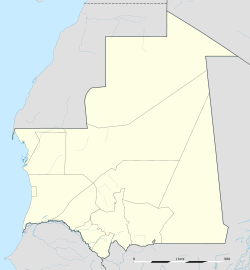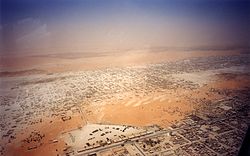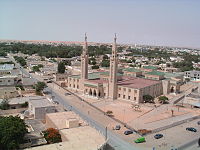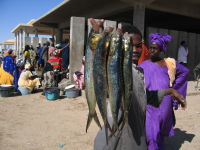
Nouakchott
Background to the schools Wikipedia
SOS Children volunteers helped choose articles and made other curriculum material Visit the SOS Children website at http://www.soschildren.org/
| Nouakchott نواكشوط |
|
|---|---|
| Central Nouakchott. | |
|
|
|
| Coordinates: 18°6′N 15°57′W Coordinates: 18°6′N 15°57′W | |
| Country | |
| Capital district | Nouakchott |
| Government | |
| • Mayor | Ahmed Hamza (2007-) |
| Area | |
| • Total | 1,000 km2 (400 sq mi) |
| Population (1999) | |
| • Total | 881,000 |
| • Density | 881/km2 (2,280/sq mi) |
Nouakchott (Arabic: نواكشوط or انواكشوط (believed translation from Berber "The place of the winds", Nawākšūṭ)) is the capital and by far the largest city of Mauritania. It is one of the largest cities in the Sahara. The city is the administrative and economic centre of Mauritania.
History
A tiny fishing town of 200 people until 1958, Nouakchott was little mentioned during pre-colonial and colonial history. It is possible that the Berber Muslim Almoravids were originally from the area. Despite its name, based on a Berber expression meaning "place of the winds", the city was selected as the capital city for its moderate climate and central location within the country. It also sat on one of the most valuable trade routes to West Africa.
Mauritania was part of the larger French colony of French West Africa, and as such had no capital during the colonial period: Saint-Louis, in Senegal, held that position. In 1957, this small port town was chosen to be the capital of the new country, and an ambitious building program was begun to increase its population to 15,000, starting a year later. In 1958, Mauritania was formed as an autonomous republic in the French Community, and in 1960 it became an independent country, with Nouakchott as its capital.
Since independence
The city was attacked in 1976 by the Polisario Front, as part of the Western Sahara independence movement. Between 1988 and 1989, racial tensions between Arabs and blacks escalated. There was discrimination and retaliation by Arabs and blacks. There were also three days of "bread riots" starting January 21, 1995.
The city has had rapid growth, driven by the north African drought since the beginning of the 1970s: many have moved to the city in search of a better life. The population is estimated to have been just under 1,000,000 in 2000, and to have grown to above 2,000,000 as of 2008.
There is currently a large amount of Chinese investment in Mauritania that is focused on the city.
Geography
Located on the Atlantic coast of the Sahara Desert, it lies on the west coast of Africa, on the Atlantic Ocean. With the exception of Nouakchott Wharf and a deep water port, the coastal strip is mostly left empty and allowed to flood. The coastline includes shifting sandbanks and sandy beaches. There are also areas of quicksand close to the harbour. The city is being covered by the sand dunes advancing from its eastern side (salmon-coloured on image to left), which pose a daily problem. There have been efforts to save particular areas, including work by Jean Meunier. The city is largely flat.
Owing to the rapid build-up, the city is quite spread out, with few tall buildings. Most buildings are one-storey only. It also often acts as an interface between urban Mauritanians and their nomadic fellow citizens.
Nouakchott is built around a large tree-lined street, Avenue Abdel Nasir, which runs northeast through the city centre from the airport. Other major streets are named (in French) for notable Mauritanian or international figures of the 1960s: Avenue Abdel Nasser, Avenue Charles de Gaulle, Avenue Kennedy, and Avenue Lumumba, for example.
The city is broken into numbered arrondissements, sub-divided into alphabetised Îlots. The Cinquième Arrondissement is home to a large shopping area.
Climate
Nouakchott features an arid climate with hot summers and warm “winters”. Because of its location, temperatures are hot for most of the year. However, Nouakchott possesses a mild temperature range compared to other cities in this climate. While average high temperatures are relatively constant at around 32 °C (89.6 °F), average low temperatures can range from 24 °C (75.2 °F) during the summer months to 13 °C (55.4 °F) during the "winter" months. Average low temperatures can be as low as 10 °C (50.0 °F) during “winter” months in Nouakchott. Average rainfall in the city is 159 millimetres (6.3 in) a year. The bulk of the precipitation typically falls within August, the one month that forms the city’s very brief wet season.
| Climate data for Nouakchott | |||||||||||||
|---|---|---|---|---|---|---|---|---|---|---|---|---|---|
| Month | Jan | Feb | Mar | Apr | May | Jun | Jul | Aug | Sep | Oct | Nov | Dec | Year |
| Record high °C (°F) | 36 (97) |
39 (102) |
41 (106) |
43 (109) |
46 (115) |
46 (115) |
43 (109) |
42 (108) |
44 (111) |
43 (109) |
42 (108) |
37 (99) |
46 (115) |
| Average high °C (°F) | 29 (84) |
31 (88) |
32 (90) |
32 (90) |
34 (93) |
33 (91) |
32 (90) |
32 (90) |
34 (93) |
33 (91) |
32 (90) |
28 (82) |
34 (93) |
| Average low °C (°F) | 14 (57) |
15 (59) |
17 (63) |
18 (64) |
21 (70) |
23 (73) |
23 (73) |
24 (75) |
24 (75) |
22 (72) |
18 (64) |
13 (55) |
19 (66) |
| Record low °C (°F) | 7 (45) |
9 (48) |
11 (52) |
12 (54) |
14 (57) |
18 (64) |
21 (70) |
20 (68) |
22 (72) |
17 (63) |
13 (55) |
7 (45) |
7 (45) |
| Precipitation mm (inches) | 0 (0) |
3 (0.12) |
0 (0) |
0 (0) |
0 (0) |
3 (0.12) |
13 (0.51) |
104 (4.09) |
23 (0.91) |
10 (0.39) |
3 (0.12) |
0 (0) |
159 (6.26) |
| Source: BBC Weather | |||||||||||||
Government
The town was first divided into districts (moughataa) in 1973. First it was divided into four. From 1986, the city has been split into nine districts.
- Arafat
- Dar Naim
- El Mina
- Ksar
- Riad
- Sebkha
- Tevragh-Zeina
- Teyarett
- Toujounine
Demographics
For comparison, its population was only 20,000 in 1969 and 150,000 in 1980. Part of the difficulty in estimating the city's population is that part of it is literally nomadic, setting up tents in suitable locations, then packing up when the need strikes. Some estimates put the 2008 population at over 2 million; more conservative estimates put that number at 800,000, itself estimated to be close to one-third of the country's population.
Slum resettlement
In 2009, the government of Mauritania announced that it would begin a process of clearing the slum on the outskirts of Nouakchott. 24,000 families would eventually be relocated to planned housing within the city. The process is scheduled to begin with the relocation of 9,000 families from the outskirts into the poor Arafat department neighbourhood of "Kosovo", popularly named for its high crime rate and poor services. The government plans to begin moving families in June 2009 despite concerns from aid agencies that needed infrastructure cannot be put in place in the receiving neighbourhood.
Infrastructure and administration
Nouakchott has a deep-sea port, opened in 1986, primarily used for imports. Annually, imports account for around 96.4% of traffic at the port. It handles 500,000–800,000 tonnes of cargo a year. Recently, China has agreed to invest US$282 million in the port, aiming to extend the main quay, the deepwater Quay of Friendship, by 500 m (1,640.42 ft). A 1,100 kilometres (680 mi) road connects the city with Néma via Boutilimit and Kiffa. The city also features an international airport, Nouakchott International Airport. Road transport is problematic, the main problem being overcrowded roads. Fuel for cars is also hard to obtain in Nouakchott.
An agreement was signed on August 5, 2007 between Mauritania, Sudan, and China to build $630m Mauritania Railway linking the port of Nouakchott and phosphate mines at Bofal, about 430 km away. The line goes near the border with Senegal.
As of 2000, it is the home to over 30 international or diplomatic institutions.
Economy
Salt, cement, insecticides, rugs, carpets, embroidery, and craft products are produced in Nouakchott, with the port also exporting copper. As of 2000, there are over 30 small or middle-sized factories in the city. Administration and financial enterprises are also important. The airline Mauritania Airways has its head office in the city. When Air Mauritanie existed, its head office was in the city.
Fresh water
Although the rocks beneath the city contained a vast reservoir of fresh water, known as the Trarza Lake, fresh water is running out, owing to the large growth of the city. Engineers have warned it could run out by 2054, since it is not rain-fed, and is therefore non-renewable. The problem is particularly bad in the sandy shanty towns where the majority of the population lives.
Many people already have to buy water, which is expensive compared with the average wage in the city.
Education
The city is home to the University of Nouakchott, which is the only university in Mauritania and was opened in 1981. Approximately 8000 students study there, and it has a considerable impact on the city, according to some. Other higher education facilities include the National School of Administration, and the National Institute of Advanced Islamic Studies. There are many primary and secondary schools, among the most prominent are the American International School of Nouakchott and the Lycée Français Théodore Monod school.
Culture and religion
Attractions in Nouakchott include Nouakchott Museum, several markets including Nouakchott Silver Market, and the beaches. One beach is devoted to fishing boats where various species of fish can be bought fresh. The city also hosts the National Library and National Archives. Nouakchott is the principal location in Africa for world distribution of native Saharan meteorites.
There is a mosque donated by Saudi Arabia in the city centre, and a Moroccan mosque further south. Although Islam is the state religion in Mauritania, Nouakchott includes the Cathedral of St. Joseph, a Catholic cathedral. It is home to the Roman Catholic Diocese of Nouakchott, founded in 1965.
International relations
Twin towns - Sister cities
Nouakchott is twinned with:









